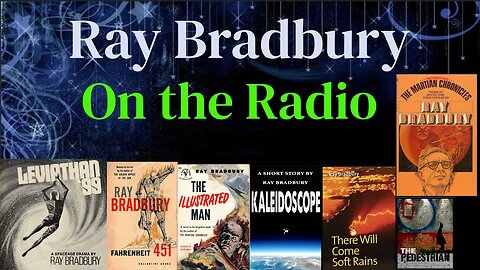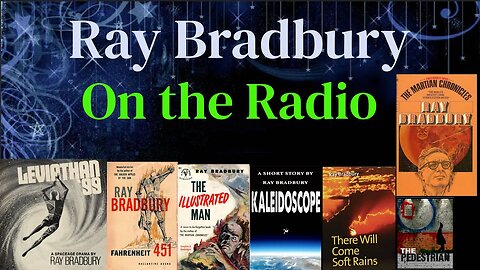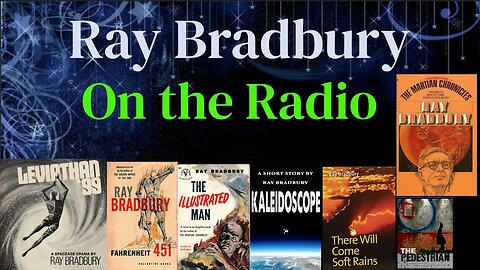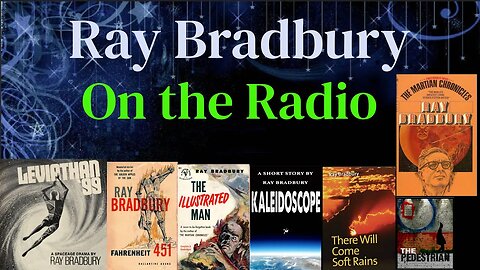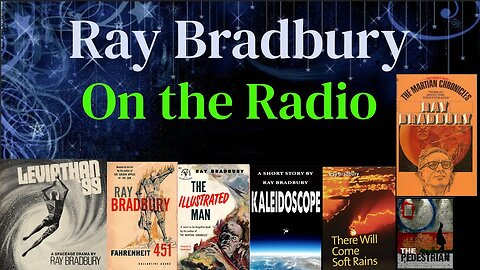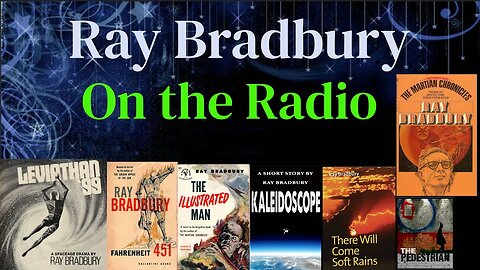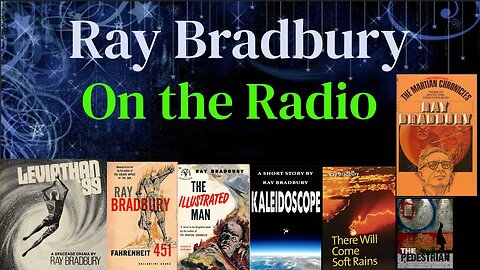
Sci-Fi Radio*
173 videos
Updated 1 month ago
Many science fiction enthusiasts consider 1950-1960 to be the Golden Era of Science Fiction. This is the decade when the best Science Fiction old time radio was created. At the same time American's non-fiction world was filled with "duck and cover" exercises, red scare, McCarthyism, and the fears of a Soviet invasion or nuclear annihilation. To many, science fiction with aliens allowed audiences to play out the fantasy of invasion by substituting Communists for aliens.
-
Ray Bradbury 2014 The Martian Chronicles (Derek Jacobi)
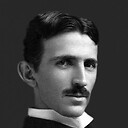 TeslaWirelessRadioThe Martian Chronicles is a science fiction fix-up novel, published in 1950, by American writer Ray Bradbury that chronicles the exploration and settlement of Mars, the home of indigenous Martians, by Americans leaving a troubled Earth that is eventually devastated by nuclear war. Synopsis The book projects American society immediately after World War II into a technologically advanced future where the amplification of humanity's potentials to create and destroy have both miraculous and devastating consequences. Events in the chronicle include the apocalyptic destruction of both Martian and human civilizations, both instigated by humans, though there are no stories with settings at the catastrophes. The outcomes of many stories raise concerns about the values and direction of America of the time by addressing militarism, science, technology, and war time prosperity that could result in a global nuclear war.57 views 2 comments
TeslaWirelessRadioThe Martian Chronicles is a science fiction fix-up novel, published in 1950, by American writer Ray Bradbury that chronicles the exploration and settlement of Mars, the home of indigenous Martians, by Americans leaving a troubled Earth that is eventually devastated by nuclear war. Synopsis The book projects American society immediately after World War II into a technologically advanced future where the amplification of humanity's potentials to create and destroy have both miraculous and devastating consequences. Events in the chronicle include the apocalyptic destruction of both Martian and human civilizations, both instigated by humans, though there are no stories with settings at the catastrophes. The outcomes of many stories raise concerns about the values and direction of America of the time by addressing militarism, science, technology, and war time prosperity that could result in a global nuclear war.57 views 2 comments -
The Kraken Wakes by John Wyndham (Apocalyptic Sci-fi Show)
 TeslaWirelessRadioThe Kraken Wakes is an apocalyptic science fiction novel by John Wyndham, originally published by Michael Joseph in the United Kingdom in 1953, and first published in the United States in the same year by Ballantine Books under the title Out of the Deeps as a mass market paperback. The novel is structured as a book within a book. After a short scene-setting introduction, the novel is the book written by the protagonist, radio reporter Mike Watson, chronicling the events that took place when creatures from the deeps of the ocean attack humanity. Mike and his wife Phyllis work for the English Broadcasting Company (EBC) so are privy to decisions by government and scientific authorities who alternatively try to counter the alien's moves or stifle or massage news to prevent panic. The aliens are never seen, and their origin and level of intelligence, if any, are never discerned. They are only known by their acts of violence against humanity, and their weapons of choice are not of the sort envisioned by humanity. The title is a reference to Alfred Tennyson's sonnet The Kraken. Plot The novel describes the course of an attack on humanity by creatures from the ocean depths, as told through the eyes of Mike Watson, who works for the English Broadcasting Company (EBC) with his wife and co-reporter Phyllis. A major role is also played by Professor Alastair Bocker – more clear-minded and far-sighted about the developing crisis than everybody else but often alienating people by telling brutally unvarnished and unwanted truths. Mike and Phyllis are witness to several events of the invasion, which proceeds in drawn-out phases; it takes years before the bulk of humanity even realizes that the world has been invaded. In the first phase, objects from outer space land in the oceans. Mike and Phyllis happen to see five of the "fireballs" falling into the sea, from the ship where they are sailing on their honeymoon. Eventually the distribution of the objects' landing points – always at ocean depths, never on land – implies intelligence.63 views
TeslaWirelessRadioThe Kraken Wakes is an apocalyptic science fiction novel by John Wyndham, originally published by Michael Joseph in the United Kingdom in 1953, and first published in the United States in the same year by Ballantine Books under the title Out of the Deeps as a mass market paperback. The novel is structured as a book within a book. After a short scene-setting introduction, the novel is the book written by the protagonist, radio reporter Mike Watson, chronicling the events that took place when creatures from the deeps of the ocean attack humanity. Mike and his wife Phyllis work for the English Broadcasting Company (EBC) so are privy to decisions by government and scientific authorities who alternatively try to counter the alien's moves or stifle or massage news to prevent panic. The aliens are never seen, and their origin and level of intelligence, if any, are never discerned. They are only known by their acts of violence against humanity, and their weapons of choice are not of the sort envisioned by humanity. The title is a reference to Alfred Tennyson's sonnet The Kraken. Plot The novel describes the course of an attack on humanity by creatures from the ocean depths, as told through the eyes of Mike Watson, who works for the English Broadcasting Company (EBC) with his wife and co-reporter Phyllis. A major role is also played by Professor Alastair Bocker – more clear-minded and far-sighted about the developing crisis than everybody else but often alienating people by telling brutally unvarnished and unwanted truths. Mike and Phyllis are witness to several events of the invasion, which proceeds in drawn-out phases; it takes years before the bulk of humanity even realizes that the world has been invaded. In the first phase, objects from outer space land in the oceans. Mike and Phyllis happen to see five of the "fireballs" falling into the sea, from the ship where they are sailing on their honeymoon. Eventually the distribution of the objects' landing points – always at ocean depths, never on land – implies intelligence.63 views -
Do Androids Dream of Electric Sheep by Philip K Dick
 TeslaWirelessRadioDo Androids Dream of Electric Sheep? (retrospectively titled Blade Runner: Do Androids Dream of Electric Sheep? in some later printings) is a 1968 dystopian science fiction novel by American writer Philip K. Dick. It is set in a post-apocalyptic San Francisco, where Earth's life has been greatly damaged by a nuclear global war, leaving most animal species endangered or extinct. The main plot follows Rick Deckard, a bounty hunter who has to "retire" (i.e. kill) six escaped Nexus-6 model androids, while a secondary plot follows John Isidore, a man of sub-par IQ who aids the fugitive androids. The book served as the basis for the 1982 film Blade Runner and, even though some aspects of the novel were changed, many elements and themes from it were used in the film's 2017 sequel Blade Runner 2049. Plot summary Rick Deckard, a bounty hunter for the San Francisco Police Department, is assigned to "retire" (kill) six androids of the new Nexus-6 model which have recently escaped from Mars and traveled to Earth. These androids are made of organic matter so similar to a human's that only a "bone marrow analysis" can prove the difference, making them almost impossible to distinguish from real people. The analysis is painful and lengthy and is in most cases posthumous. Deckard hopes this mission will earn him enough money to buy a live animal to replace his lone electric sheep to comfort his depressed wife Iran. Deckard visits the Rosen Association's headquarters in Seattle to confirm the accuracy of the latest empathy test meant to identify incognito androids. Deckard suspects the test may not be capable of distinguishing the Nexus-6 models from genuine human beings, and it appears to give a false positive on his host in Seattle, Rachael Rosen, meaning the police have potentially been executing human beings. The Rosen Association attempts to blackmail Deckard to get him to drop the case, but Deckard retests Rachael and determines that Rachael is, indeed, an android, which she ultimately admits.57 views
TeslaWirelessRadioDo Androids Dream of Electric Sheep? (retrospectively titled Blade Runner: Do Androids Dream of Electric Sheep? in some later printings) is a 1968 dystopian science fiction novel by American writer Philip K. Dick. It is set in a post-apocalyptic San Francisco, where Earth's life has been greatly damaged by a nuclear global war, leaving most animal species endangered or extinct. The main plot follows Rick Deckard, a bounty hunter who has to "retire" (i.e. kill) six escaped Nexus-6 model androids, while a secondary plot follows John Isidore, a man of sub-par IQ who aids the fugitive androids. The book served as the basis for the 1982 film Blade Runner and, even though some aspects of the novel were changed, many elements and themes from it were used in the film's 2017 sequel Blade Runner 2049. Plot summary Rick Deckard, a bounty hunter for the San Francisco Police Department, is assigned to "retire" (kill) six androids of the new Nexus-6 model which have recently escaped from Mars and traveled to Earth. These androids are made of organic matter so similar to a human's that only a "bone marrow analysis" can prove the difference, making them almost impossible to distinguish from real people. The analysis is painful and lengthy and is in most cases posthumous. Deckard hopes this mission will earn him enough money to buy a live animal to replace his lone electric sheep to comfort his depressed wife Iran. Deckard visits the Rosen Association's headquarters in Seattle to confirm the accuracy of the latest empathy test meant to identify incognito androids. Deckard suspects the test may not be capable of distinguishing the Nexus-6 models from genuine human beings, and it appears to give a false positive on his host in Seattle, Rachael Rosen, meaning the police have potentially been executing human beings. The Rosen Association attempts to blackmail Deckard to get him to drop the case, but Deckard retests Rachael and determines that Rachael is, indeed, an android, which she ultimately admits.57 views -
Deep Station Emerald by Joe Turner
 TeslaWirelessRadioJoe Turner's four-part drama is a futuristic undersea thriller The crew of a research base on the ocean floor discovers a source of cold fusion, the solution to all the world's energy problems. Elation turns to terror, however, when a series of 'accidents' causes several deaths, and a strange virus which mutates DNA is loosed... obviously, someone on board is a killer...36 views
TeslaWirelessRadioJoe Turner's four-part drama is a futuristic undersea thriller The crew of a research base on the ocean floor discovers a source of cold fusion, the solution to all the world's energy problems. Elation turns to terror, however, when a series of 'accidents' causes several deaths, and a strange virus which mutates DNA is loosed... obviously, someone on board is a killer...36 views -
Ray Bradbury 2014 The Illustrated Man (Iain Glen)
 TeslaWirelessRadioThe Illustrated Man is a 1951 collection of 18 science fiction short stories by American writer Ray Bradbury. A recurring theme throughout the stories is the conflict of the cold mechanics of technology and the psychology of people. It was nominated for the International Fantasy Award in 1952. The unrelated stories are tied together by the frame story of "The Illustrated Man", a vagrant former member of a carnival freak show with an extensively tattooed body whom the unnamed narrator meets. The man's tattoos, allegedly created by a time-traveling woman, are individually animated, and each tells a different tale. All but one of the stories had been published previously elsewhere, although Bradbury revised some of the texts for the book's publication. The book was made into the 1969 film, The Illustrated Man, starring Rod Steiger and Claire Bloom. It presents adaptations of the stories "The Veldt", "The Long Rain" and "The Last Night of the World". Some of the stories, including "The Veldt", "The Fox and the Forest" (as "To the Future"), "Marionettes, Inc.", and "Zero Hour" were also dramatized for the 1955–1957 radio series X Minus One. "The Veldt", "The Concrete Mixer", "The Long Rain", "Zero Hour", and "Marionettes Inc." were adapted for The Ray Bradbury Theater television series. "The Fox and the Forest" was adapted by Terry Nation for the 1965 BBC television series Out of the Unknown.46 views
TeslaWirelessRadioThe Illustrated Man is a 1951 collection of 18 science fiction short stories by American writer Ray Bradbury. A recurring theme throughout the stories is the conflict of the cold mechanics of technology and the psychology of people. It was nominated for the International Fantasy Award in 1952. The unrelated stories are tied together by the frame story of "The Illustrated Man", a vagrant former member of a carnival freak show with an extensively tattooed body whom the unnamed narrator meets. The man's tattoos, allegedly created by a time-traveling woman, are individually animated, and each tells a different tale. All but one of the stories had been published previously elsewhere, although Bradbury revised some of the texts for the book's publication. The book was made into the 1969 film, The Illustrated Man, starring Rod Steiger and Claire Bloom. It presents adaptations of the stories "The Veldt", "The Long Rain" and "The Last Night of the World". Some of the stories, including "The Veldt", "The Fox and the Forest" (as "To the Future"), "Marionettes, Inc.", and "Zero Hour" were also dramatized for the 1955–1957 radio series X Minus One. "The Veldt", "The Concrete Mixer", "The Long Rain", "Zero Hour", and "Marionettes Inc." were adapted for The Ray Bradbury Theater television series. "The Fox and the Forest" was adapted by Terry Nation for the 1965 BBC television series Out of the Unknown.46 views -
Ray Bradbury 2011 Something Wicked This Way Comes (dramatized by Diana Griffiths)
 TeslaWirelessRadioSomething Wicked This Way Comes is a 1962 dark fantasy novel by Ray Bradbury. It is about two 13-year-old best friends, Jim Nightshade and William Halloway, and their nightmarish experience with a traveling carnival that comes to their Midwestern home, Green Town, Illinois, on October 24th. In dealing with the creepy figures of this carnival, the boys learn how to combat fear. The carnival's leader is the mysterious "Mr. Dark", who seemingly wields the power to grant the townspeople's secret desires. In reality, Dark is a malevolent being who, like the carnival, lives off the life force of those they enslave. Mr. Dark's presence is countered by that of Will's father, Charles Halloway, the janitor of the town library, who harbors his own secret fear of growing older because he feels he is too old to be Will's dad. The novel combines elements of fantasy and horror, analyzing the conflicting natures of good and evil that exist within all individuals. Unlike many of Bradbury's other novel-length works, such as Dandelion Wine and The Martian Chronicles, which are fix-ups, Something Wicked This Way Comes is a single, full-length narrative. The title is taken from "By the pricking of my thumbs, something wicked this way comes", a line said by the witches in Shakespeare's Macbeth.42 views
TeslaWirelessRadioSomething Wicked This Way Comes is a 1962 dark fantasy novel by Ray Bradbury. It is about two 13-year-old best friends, Jim Nightshade and William Halloway, and their nightmarish experience with a traveling carnival that comes to their Midwestern home, Green Town, Illinois, on October 24th. In dealing with the creepy figures of this carnival, the boys learn how to combat fear. The carnival's leader is the mysterious "Mr. Dark", who seemingly wields the power to grant the townspeople's secret desires. In reality, Dark is a malevolent being who, like the carnival, lives off the life force of those they enslave. Mr. Dark's presence is countered by that of Will's father, Charles Halloway, the janitor of the town library, who harbors his own secret fear of growing older because he feels he is too old to be Will's dad. The novel combines elements of fantasy and horror, analyzing the conflicting natures of good and evil that exist within all individuals. Unlike many of Bradbury's other novel-length works, such as Dandelion Wine and The Martian Chronicles, which are fix-ups, Something Wicked This Way Comes is a single, full-length narrative. The title is taken from "By the pricking of my thumbs, something wicked this way comes", a line said by the witches in Shakespeare's Macbeth.42 views -
Ray Bradbury 2007 The Veldt (adapted by Mike Walker from his stage play)
 TeslaWirelessRadio"The Veldt" is a science fiction short story by American author Ray Bradbury. Originally appearing as "The World the Children Made" in the September 23, 1950, issue of The Saturday Evening Post, it was republished under its current name in the 1951 anthology The Illustrated Man. In the story, a mother and father struggle with their technologically advanced home taking over their role as parents, and their children becoming uncooperative because of their lack of discipline. Plot The Hadley family lives in an automated house called "the Happylife Home", filled with machines that aid them in completing everyday tasks, such as tying their shoes, bathing them, or cooking their food. The two children, Peter and Wendy,[a] enjoy time in the "nursery", a virtual reality room able to realistically reproduce any place they imagine, and grow increasingly attached to it. The parents, George, and Lydia, begin to wonder if there is something wrong with their way of life.35 views
TeslaWirelessRadio"The Veldt" is a science fiction short story by American author Ray Bradbury. Originally appearing as "The World the Children Made" in the September 23, 1950, issue of The Saturday Evening Post, it was republished under its current name in the 1951 anthology The Illustrated Man. In the story, a mother and father struggle with their technologically advanced home taking over their role as parents, and their children becoming uncooperative because of their lack of discipline. Plot The Hadley family lives in an automated house called "the Happylife Home", filled with machines that aid them in completing everyday tasks, such as tying their shoes, bathing them, or cooking their food. The two children, Peter and Wendy,[a] enjoy time in the "nursery", a virtual reality room able to realistically reproduce any place they imagine, and grow increasingly attached to it. The parents, George, and Lydia, begin to wonder if there is something wrong with their way of life.35 views -
Ray Bradbury 1982 Fahrenheit 451 (dramatized by Gregory Evans)
 TeslaWirelessRadioFahrenheit 451 is a 1953 dystopian novel by American writer Ray Bradbury.[4] It presents an American society where books have been personified and outlawed and "firemen" burn any that are found.[5] The novel follows Guy Montag, a fireman who becomes disillusioned with his role of censoring literature and destroying knowledge, eventually quitting his job and committing himself to the preservation of literary and cultural writings.32 views
TeslaWirelessRadioFahrenheit 451 is a 1953 dystopian novel by American writer Ray Bradbury.[4] It presents an American society where books have been personified and outlawed and "firemen" burn any that are found.[5] The novel follows Guy Montag, a fireman who becomes disillusioned with his role of censoring literature and destroying knowledge, eventually quitting his job and committing himself to the preservation of literary and cultural writings.32 views -
Ray Bradbury 2004 The Pedestrian (read by David Horovitch)
 TeslaWirelessRadio"The Pedestrian" is a science fiction short story by American writer Ray Bradbury. This story was originally published in the August 7, 1951 issue of The Reporter by The Fortnightly Publishing Company.[1] It is included in the collection The Golden Apples of the Sun (1953), but was dropped from later editions of this collection (1990 and 1997). Summary The story features Leonard Mead, a citizen of a television-centered world in November of A.D. 2053. In the city the sidewalks have fallen into decay. Mead enjoys walking through the city at night, something which no one else does. "In ten years of walking by night or day, for thousands of miles, he had never met another person walking, not one in all that time." On one of his usual walks, he encounters a police car, which is robotic. It is the only police unit in a city of three million as the purpose of law enforcement has disappeared with everyone watching television at night. When asked about his profession Mead tells the car that he is a writer, but the car does not understand since no one buys books or magazines in the television-dominated society. The police car, which is revealed to have no occupants, cannot understand why Mead would be out walking for no reason, and so it decides to take him to the Psychiatric Center for Research on Regressive Tendencies. As the car passes through his neighborhood, Mead, locked in the confines of the back seat says, "That's my house," as he points to a warm and bright house with all its lights on, unlike all the other houses. There is no reply, and the story concludes.29 views
TeslaWirelessRadio"The Pedestrian" is a science fiction short story by American writer Ray Bradbury. This story was originally published in the August 7, 1951 issue of The Reporter by The Fortnightly Publishing Company.[1] It is included in the collection The Golden Apples of the Sun (1953), but was dropped from later editions of this collection (1990 and 1997). Summary The story features Leonard Mead, a citizen of a television-centered world in November of A.D. 2053. In the city the sidewalks have fallen into decay. Mead enjoys walking through the city at night, something which no one else does. "In ten years of walking by night or day, for thousands of miles, he had never met another person walking, not one in all that time." On one of his usual walks, he encounters a police car, which is robotic. It is the only police unit in a city of three million as the purpose of law enforcement has disappeared with everyone watching television at night. When asked about his profession Mead tells the car that he is a writer, but the car does not understand since no one buys books or magazines in the television-dominated society. The police car, which is revealed to have no occupants, cannot understand why Mead would be out walking for no reason, and so it decides to take him to the Psychiatric Center for Research on Regressive Tendencies. As the car passes through his neighborhood, Mead, locked in the confines of the back seat says, "That's my house," as he points to a warm and bright house with all its lights on, unlike all the other houses. There is no reply, and the story concludes.29 views -
Ray Bradbury 1994 Shoreline at Sunset (read by Ed Bishop)
 TeslaWirelessRadioThe Shore Line at Sunset Tom and his friend Chico share a house on the beach off the Coast Highway. Tom is a lonely man, wanting more than anything else to find the perfect girl to marry. Several times in the past he thought that he had found such a girl. Yet every time he brings a girl home, she always decides not to stay. All of Tom's great expectations have ended in failure. He is considering moving away, and it is during this low point in Tom's life that a young boy from the beach brings him news of a "funny" woman who has been washed up on the shore. Tom and Chico go to view this sight and are amazed to see a beautiful mermaid at the water's edge. Chico immediately recognizes the monetary value in the mermaid.25 views
TeslaWirelessRadioThe Shore Line at Sunset Tom and his friend Chico share a house on the beach off the Coast Highway. Tom is a lonely man, wanting more than anything else to find the perfect girl to marry. Several times in the past he thought that he had found such a girl. Yet every time he brings a girl home, she always decides not to stay. All of Tom's great expectations have ended in failure. He is considering moving away, and it is during this low point in Tom's life that a young boy from the beach brings him news of a "funny" woman who has been washed up on the shore. Tom and Chico go to view this sight and are amazed to see a beautiful mermaid at the water's edge. Chico immediately recognizes the monetary value in the mermaid.25 views



